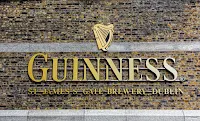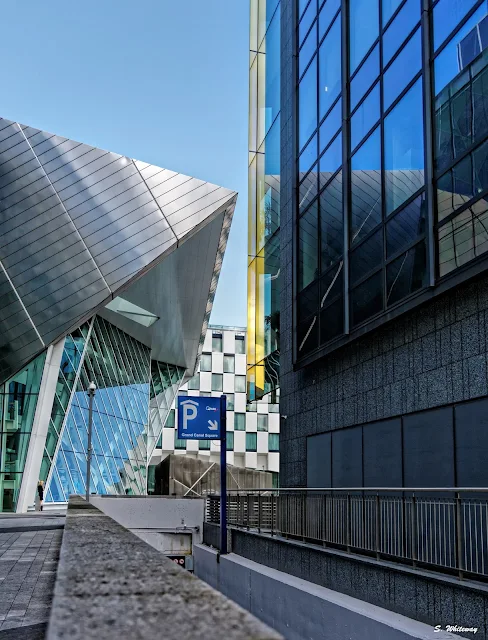After a long winter recovering from a broken leg; my photos and my blog had gone inactive. It's hard to review and process photos as well as write when you are restricted in your range of movement and a bit mad at the world, as well. By the time I was back to my new normal, it was late spring and all the activities that brings including golf, hiking, travels and enjoying the weather as well as physiotherapy, took up my free time. So I have been slow getting back to my blog.
 |
| St. Patrick's Cathedral, Dublin Ireland |
Dublin was not high on my places to visits in Europe but Westjet’s first transatlantic offering; a seasonal, non-stop flight between St. John’s and Dublin offered a new and quick gateway for our travels to Europe and so Dublin quickly moved up the list. My first impression of Dublin was that it seems to retain a sense of civility often lost in big cities, so that it has the feel of a small city that is sized just right; that is to say it is not overwhelming and its compactness just makes it feel all the more charming. It seems to have developed the knack for blending old and new. It’s a city that is easy to walk or bike (it has a bike sharing program) with many of the attractions, activities, pubs and restaurants close to the main hotels in the central core.
The Irish hospitality is legendary and considering that they are a chatty and gregarious lot, well it is understandable that the pub remains to a certain degree the heart of Dublin’s (and Ireland's) social existence. It is the window through which you can view and experience the very essence of the city’s and by extension the country's culture. The pub is the meeting place where camaraderie and companionship flourish, as well as, conversation that is often accompanied by an enthusiastic exchange of views, humor and musings. Music also seems to be permanently imprinted on the Irish psyche and it is often the locale pub where this art form thrives. The pub is modern Ireland's vehicle that continues a revered vocation that predates Christianity; that of the bardic tradition; a masterful blend of lyric, rhyme and music that passed on legends and histories thereby preserving and sharing their culture. The Irish were and are indeed masters of this tradition and hopefully economic uncertainty, changing societal views and habits, as well as the advent of social media does not result in the lost of a mainstay of Irish Society; the locale pub, because sadly some of Irish culture may also be lost.
 |
The Irish Staple, the mighty potato
which was a side to a delicious Beef and Guinness Pie. |
In many ways Dublin felt like home. The Irish are obsessed with the weather; they talk about it all the time and it's woven its way into their vocabulary. Sound familiar? Weather was one, if not the first topic of conversation we had upon arriving in Ireland. The Irish 2015 July was remarkably similar to St. John’s 2015 July; cold and wet. Or maybe it had something to do with the fact that less than an hour after arrival, my husband had already been identified as Irish (the first of many more times this would occur). Ok, that reaction is to be expected as Newfoundland and Ireland are places where accents collide and their shared ancestry is immediately obvious when they speak (although his ancestry is actually English). Then again, it might the shared phrases that brought forth a smile and chuckle to hear an ocean away. It could possibly have been the fact I couldn’t understand half of them because of the accents or the speed at which they were talking. They’re not talking too fast, you’re listening too slow seems to be a problem I have at home too, so yes indeed very familiar. There are more varieties of English spoken in Newfoundland and Labrador than anywhere else in the world and our accents and vocabulary are flavoured by Southern Ireland. Or then again it might have been the food! For one who does not considered the potato to be a necessary food staple, Ireland was a little too much like home in this instance. Chips seemed to be served with every meal and if not it was a potato in some form or another.
 |
| Dublin's Ha'Penny Bridge |
Yes, Dublin indeed felt like home. The people (they gladly provide directions and numerous excellent recommendations of places, attractions, pubs and restaurants to visit as well as to advise that the Temple Bar Area is for tourists and not locales), our shared ancestry (a few immediately knew my husband might be a Newfoundlander), the music (we don’t need to go to Ireland for that, George Street is a lot closer), and the food all felt hauntingly familiar despite being an ocean apart.
When in Dublin, a visit for a pint should alwaysbe on the agenda:
http://sandrawhiteway.blogspot.ca/2015/10/dont-be-afraid-of-dark.html
Dublin has some interesting Street Art.
http://sandrawhiteway.blogspot.ca/2015/11/the-medium-is-message.html
The Great Famine is commemorated in many ways, none more evocative than Rowan Gillepie's Sculpture series, "Famine".
http://sandrawhiteway.blogspot.ca/2015/11/an-gorta-mor-great-famine.html
Photographs from Dublin (August 2015)
The Record Tower, the sole surviving tower of the medieval castle dates back to around 1228. The Chapel Royal in Dublin Castle was completed in 1814. In Dublin Castle there is a sculpture of Lady Justice that is not blindfolded. Because of the rain, the scales always tipped to one side. Her sword is raised in a warlike pose. And she faces the castle courtyard and not the city. To the Irish the totality of these changes to the traditional Lady Justice are an allegory of the unjust legal system that was in place under British rule.
 |
| Chapel Royale and Record Tower of Dublin Castle |
 |
| The Irish Lady Justice at Dublin Castle. |
Dublin’s was one of the world’s great Georgian cities (mid- to late-18th century) and today there are many sections of Georgian terraces remaining. While the houses in each terrace are pretty much the same along the street, each door is different. The urban legend is that a Dubliner got a bit tipsy and when he came home, given the similarity of all the terrace houses, he stumbled into the wrong house and into the wrong bed. The women of Dublin went out and painted the doors different colors so as to solve that problem. An alternate story says that upon the death of Queen Victoria, the Irish were ordered to paint their doors black in mourning. They immediately went out and got the brightest colors possible to repaint their doors. In reality, it was likely a way to expression their individuality in a world of conformity that quickly caught on, but the stories make it fun.
 |
| Georgian Terrace and Painted Doors |

The River Liffey divides Dublin into the North and South sides of the city and like many places a north/south divide exists. The reputation that North Dublin is a bit rough, tough, and scruff whereas South Dublin is considered better. Just enjoy Dublin from whatever side of the river you maybe on.
 |
| The River Liffey in Dublin |
 |
| Samuel Beckett Bridge on the Rive Liffey |
 |
| Blending of the Old and the New alond the River Liffey |
The Great Famine was a period of mass starvation, disease, and emigration in Ireland between 1845 and 1852. The Great Famine is memorialised in many locations throughout Ireland, and one such memorial is located Custom House Quays in Dublin.
 |
| Famine (1997) by Rowan Gillespie |
Dublin like many other cities have beautiful sculptures and monuments for all to enjoy.
 |
| O'Connell Monument on O'Connell Street in Dublin |
 |
| Oscar Wilde Statue in Merrion Square, Dublin. The materials are granite, green nephrite jade, white jadeite and thulite |
 |
| Theobald Wolfe Tone on the edge of St. Stephen's Green |
 The tour is self guided so you could spend as little or as much time as you wanted viewing the storehouse. It is NOT a brewery tour so you will not see a working brewery, which is an experience in itself. It is essentially a museum of sorts house in the original brewery showcasing older models of machinery used to make beer, vintage Guinness advertisements and various assorted information about Guinness beer and their brewing process. As an enthusiastic amateur photographer, the Guinness Storehouse presented a variety of objects and textures that would delight and tempt most photographers. It was also interesting to learn a bit about the brewing process from the Guinness perspective.
The tour is self guided so you could spend as little or as much time as you wanted viewing the storehouse. It is NOT a brewery tour so you will not see a working brewery, which is an experience in itself. It is essentially a museum of sorts house in the original brewery showcasing older models of machinery used to make beer, vintage Guinness advertisements and various assorted information about Guinness beer and their brewing process. As an enthusiastic amateur photographer, the Guinness Storehouse presented a variety of objects and textures that would delight and tempt most photographers. It was also interesting to learn a bit about the brewing process from the Guinness perspective.































